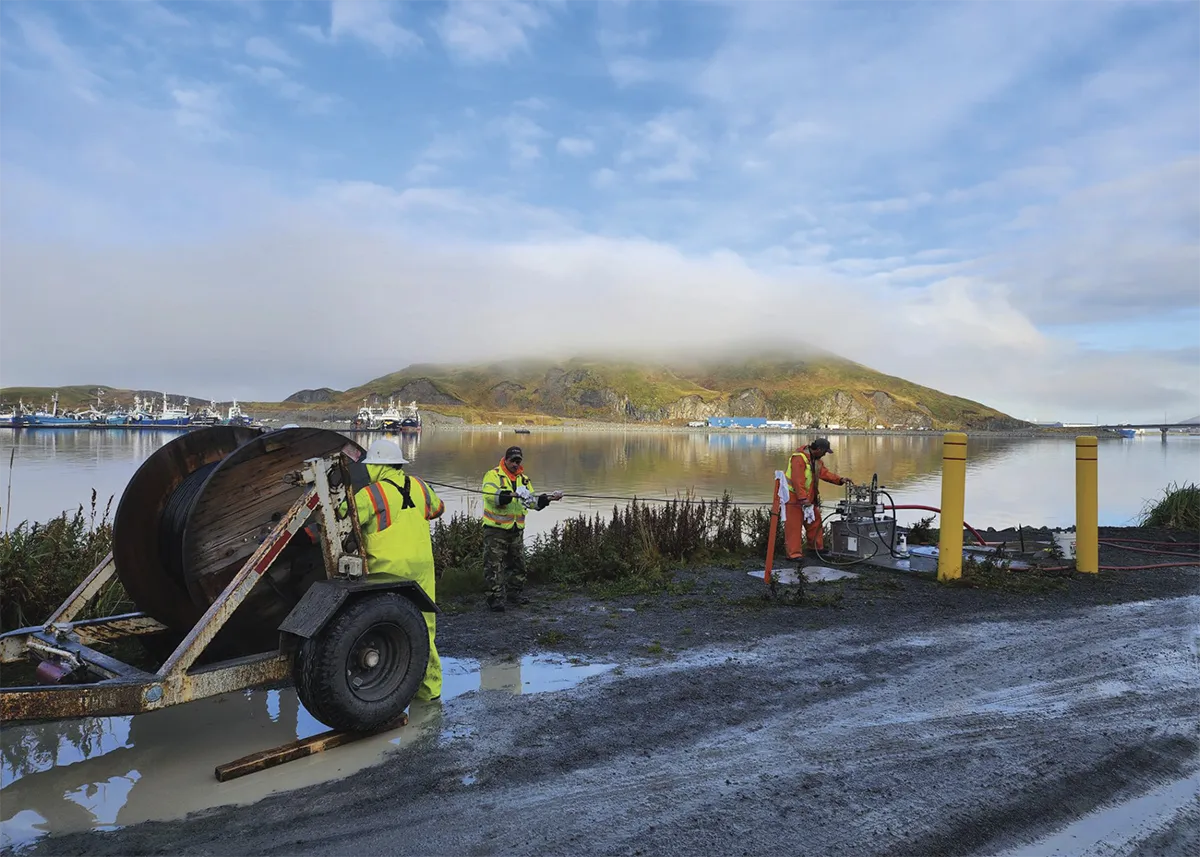ith the recent advent of fiber optic connectivity in Unalaska, GCI customers in the remote Aleutian town have unprecedented access to ultra-fast internet—and virtually the world. GCI’s customers in Unalaska are experiencing all the benefits fiber has to offer, says Rural Affairs Director Jenifer Nelson. “We launched 2-gig residential internet service in December 2022, but didn’t stop there,” she says. “Just a few months after the service launched in the community, we upped the speeds of our top-tier consumer internet plan to 2.5 gigs in all our fiber-served markets, including Unalaska,” she says.
GCI

GCI is essentially offering its full suite of high-speed internet and wireless plans through the company’s flagship GCI+ product in Unalaska. The availability of these plans in the remote Aleutian community means that residents now have access to urban-level connectivity and urban-level prices. “GCI+ combines Alaska’s fastest internet and unlimited mobile service with plans starting at just $99.99 per month,” the company stated in a May press release. “Upgrades for speed and unlimited usage are available at three additional levels.”

GCI
The AU-Aleutians Fiber Project, which has been in the making for several years, has two main components: a subsea fiber optic system and onshore network improvements. Last July, GCI began the process of running approximately 800 miles of subsea optic fiber from Kodiak along the south side of the Alaska Peninsula and the Aleutian Islands to Unalaska. By last fall, the fiber optic backbone was in place and ready for communities to begin connecting to the new network.
Fiber is generally considered to be the gold standard for broadband connectivity; it provides the fastest broadband internet speeds with the greatest capacity.

GCI
Katherine McGlashan, executive director of the Unalaska Visitors Bureau, agrees. Getting GCI’s high-speed internet service installed in April has had a major impact on her organization. Now the local visitors bureau—which has an office in the Safeway Plaza and three employees—can conduct business much more effectively. For instance, staff can complete Zoom meetings without their faces freezing, download photos in seconds instead of minutes, and transmit vital information to cruise ships more efficiently. “We chose GCI because of the reliability and the speed… We’re really happy with it and haven’t run into any issues,” McGlashan says.
The availability of fiber optic connectivity in the Aleutian region will also be transformative for GCI’s residential customers. Residents will not only be able to use streaming services, play online games, use home e-learning platforms, and do other activities online that people in urban areas have long taken for granted, but Nelson notes that they are also going to be able to bring themselves, their culture, their experiences, and their economies to the rest of the world. “What’s more is that through the Affordable Connectivity Program [ACP], qualifying Alaskans will have access to GCI’s base-level plan, which is more than twenty-five times faster than the old satellite-based plan, at no cost to themselves,” she says.
The ACP is an important Federal Communications Commission benefit program that helps ensure households can afford the broadband they need for work, school, healthcare, and other purposes. The program provides a discount of up to $30 per month toward internet service for eligible households and up to $75 per month for households on qualifying tribal lands. Under the ACP, the entire state of Alaska falls under the provisions for “qualifying tribal lands.” In addition, all households that are eligible for the program can receive a one-time discount of up to $100 to purchase a laptop, tablet, or desktop computer from participating providers.
Sand Point has about 900 year-round residents and occupies less than 10 square miles, yet the community is home to the largest fleet of commercial fishing vessels in the Aleutian region. Trident Seafoods and Peter Pan Seafood have operations in Sand Point, causing the population to instantly multiply in the summer during the salmon fishing season. The impending installation of high-speed internet in Sand Point will significantly enhance living and working conditions for residents as well as non-residents.
Currently, GCI’s installation crews are on the ground in King Cove and Sand Point, where they have made significant progress, says GCI Project Manager Mike Bertsch. The crews have been busy digging trenches, deploying tens of thousands of feet of conduit that will house and protect the local fiber network, and connecting homes and businesses to the new infrastructure. As of June, according to Bertsch, “We’re nearly finished deploying conduit and will soon be pulling the fiber through that conduit and will be dropping fiber directly to buildings throughout both communities. We expect to launch fiber optic service in King Cove and Sand Point by the end of 2023.”
To support the installation efforts, GCI is working to prepare residents of each community for the launch of 2.5 gig internet in their area. For instance, the company is encouraging interested parties to sign up when fiber is being installed in their location rather than waiting to request it later. Application forms for King Cove and Sand Point residents state: “Completing this form does NOT commit residents to GCI service but does ensure that the necessary equipment is in place should a resident choose to become a GCI customer in the future. Local residents who decide to become GCI customers after the crews leave may face significant wait-times before installation crews and specialized equipment return to the community.”
Once GCI’s crews are finished in Sand Point and King Cove, they will continue to the next set of AU-Aleutians communities and begin the groundwork soon after.

GCI
Exactly when this stage of the AU-Aleutians Fiber Project will commence has yet to be determined. “We don’t have a timeline on Phase II yet, but our teams are working to connect all AU-Aleutians Fiber Project communities as quickly and efficiently as possible,” Bertsch says.
“We’re always looking for ways to extend our fiber optic network to more Alaska communities when feasible, and we’ll continue to keep an eye out for those opportunities in the Aleutians,” Nelson says. “Aside from network expansion, we’re very excited that those communities that will be connected through the Aleutians Fiber Project will also benefit from GCI’s commitment to reaching 5 gig and 10 gig residential internet speeds in the coming years.”
These aren’t just incremental improvements, Nelson adds. “We want to deliver transformational change and are committed to closing the digital divide in the state we call home,” she says. “Approximately 80 percent of Alaskans currently have access to 2.5 gig residential internet speeds—some of the fastest in the nation—through GCI’s fiber-optic network. And that number will continue to grow as the AU-Aleutians Fiber Project and the Airraq network, which will deliver fiber-optic connectivity to ten Western Alaska communities in the coming years, are complete.”